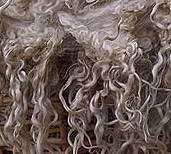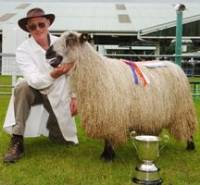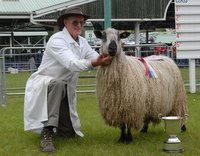 |
 |
 |
TO ORDER please email your requirements to freda@teeswaterwools.co.uk and we will send you a PayPal payment request or invoice.
PLEASE NOTE price only includes shipping within the UK postal area.
| Home |
| About Us |
| Teeswater Fleece |
| Wensleydale Fleece |
| Other Rare Breed Fleece |
| Dyed Locks |
| Contact |
| Holiday Accommodation |

Knitting Magazine feature A week in the life of Freda Pilkington (PDF)
Teeswater hogg takes top prize A TEESWATER hogg in wool took the limelight at the culmination of the sheep judging yesterday when it was crowned the overall winner of the interbreed Wool on the Hoof competition. It was shown by its owner and breeder, retired farmer Darrell Pilkington, of Rimmington, near Clitheroe, who keeps 10 Teeswater breeding ewes as a hobby on the family's 300 acre Higher Gills Farm on the Yorkshire-Lancashire border. The animal, which was entered in the Lustre Longwool section, took first place in class on Tuesday and yesterday pushed the Ryeland shearling ewe, entered in the Down category by Sandra Davison, of Kilburn, near Thirsk, into reserve spot. The judge, Malcolm Hudson, a retired wool buyer, of Shipley, described the winner as "a good example of the breed – "very clean and having no excess grease in the wool." Yorkshire Post 13/07/07 |
|
One the rarest shows rare quality, too The Teeswater shearling tup, owned by retired Lancashire farmer Darrell Pilkington, earlier won the lustre longwool section of the competition. The judge Malcolm Hudson, a retired wool buyer from Shipley, described the ram's fleece as "a beautiful fleece that was clean and of the highest quality and a great credit to the Teeswater breed". Mr Pilkington runs a flock of just ten ewes of this endangered breed at Rimington, near Clitheroe. He has won the Teeswater breed championship three times at the Great Yorkshire and said selecting breeding stock with good fleece quality was still an important consideration - although the sheep itself had to be good too. "The breed is renowned for its high lustre fleece, but what's underneath the wool is important too," he said. "It's no good having a fancy fleece on a poor sheep. We're aiming to breed the complete package - good wool and a good sheep." Mr Pilkington, who took the championship trophy and the lustre longwool section trophy, expects his champion to yield 6kg of wool when it is clipped this month. from Darlington and Stockton Times Teeswaters continue to provide quality from rare breed By Robert Benson Agricultural Correspondent TEESWATER sheep are among the rarest sheep in the world with around 400 registered breeding females left in Britain. But for the last 30 years retired Lancashire farmer Darrell Pilkington has stayed loyal to the Teeswater – a breed renowned for its high-lustre fleece – and this year he won one of the most coveted "wool on the hoof" awards. He and his wife, Freda, still live at Higher Gills Farm, Rimington, near Clitheroe – now run by their son Keith. But the farm is also home to the family's small pedigree flock of Teeswater sheep. It was one of these that scooped the prestigious Wool on the Hoof inter-breed championship at the Great Yorkshire Show in July. It was the first time the Pilkington's have entered a Wool on the Hoof competition for 16 years. Widely recognised as the most hotly contested competition of its type in Britain, it attracts breeders who continue to take a great pride in fleece quality. The Great Yorkshire Show winner for Darrell Pilkington was a shearling ram and is to be used for semen collection for export. The Teeswater may be among the world's rarest sheep but it is also one of the biggest with mature ewes weighing over 100kg. The breed's distinctive "purl" fleece and the ringlets of wool that fall over its forehead continue to win admirers. But the Pilkingtons always ensure newcomers to the breed fully appreciate that Teeswater sheep demand a high standard of flock management. Mr Pilkington said: "You can never mistake a Teeswater and although they appeal to those wanting to keep a small flock of a rare breed, they are large sheep, have big appetites and can take a lot of handling. "While the Teeswater is a good sheep for those who want to do a bit of hobby farming it's a breed that requires a high standard of flock management." The 1940s to 1970s were the heydays of the breed when the Teeswater was widely used as the sire of Masham breeding females that were bred for commercial prime lamb producers. "The breed's pool of genetics is narrowing and it's increasingly a challenge to plan your breeding programme. The Teeswater is changing to some degree as the prime lamb market demands a smaller meatier carcase and tighter skinned lamb. "If the breed is going to retain its support from farmers we must produce a typical Teeswater to meet these requirements. Conformation is always important but it must not be taken to the extreme to the detriment of the quality of the fleece and other essential breed traits such as longevity, easy lambing and prolificacy," he said. The Pilkingtons still have regular buyers for shearling rams who use them on many different breeds but predominantly Dalesbred, Swaledale, Scotch Blackface, Lonk and Derbyshire Gritstone ewes. Wool quality is particularly important to Darrell and Freda Pilkington who have recently started a new business based on Teeswater wool. "The Teeswater's skin – or fleece – has been developed over generations of breeding but there are slight variations – it's something that enables commercial farmers using the Teeswater as a crossing sire to select tups with a fleece type most suited to their particular ewe breed. "Some farmers want a fine woolled tup whereas others need a tup with a much stronger type of wool or possibly more or less purl in the fleece," he said, "A good, fine-woolled sheep with an even purl throughout the fleece is what we want here in the Trough of Bowland where we get a lot of rain. Some breeders have reduced the amount of wool on their Teeswaters to meet the commercial demands of prime lamb producers who wanted less wool on the Masham – but Teeswater wool quality has definitely not deteriorated." The Pilkington's 2007 Great Yorkshire Show Wool on the Hoof champion was clipped after the show and produced a washed fleece weight of 4kg and like all wool produced by the flock, it is destined for the couple's new business – "Teeswater Wools from Higher Gills Farm". Wool is offered for spinning knitting and dyeing – including knitting kits – and is also made up into garments, throws and other items. The Teeswater's rare breed status means its wool doesn't have to be sold through the British Wool Marketing Board. "The breed's fleece has always had a reputation for producing high quality woollen products," said Freda Pilkington who processes all the wool on the farm. Products and garments are either crafted by herself or woven at a mill with traditional production methods which is considered to be very important to ensure that the fine quality of the wool is retained. First clip wool usually has a staple length of between 24cm-30cm British Wool Marketing Board product development manager Tim Booth said it was important that farmers continued to support competitive wool classes to ensure wool quality can be maintained. "The UK has more indigenous sheep breeds than any other country in the world and it is a great credit to our breeders that they can field such an impressive turn-out of sheep at our leading shows during the summer in the Wool on the Hoof classes. "Every breed has evolved over the years to suit a particular terrain or region in the UK and the wool on the back of every one of those breeds plays a major role in its ability to survive and thrive in that location," said Mr Booth. Yorkshire Post 26/10/2007
|
|
|

